Evaluation of Satellite-Based Precipitation Products from IMERG V04A and V03D, CMORPH and TMPA with Gauged Rainfall in Three Climatologic Zones in China
Abstract
1. Introduction
2. Study Areas, Datasets and Methodology
2.1. Study Areas
2.1.1. Tibetan Plateau
2.1.2. Huaihe River Basin
2.1.3. Weihe River Basin
2.2. Gauge Precipitation Observations
2.3. Satellite-Based Precipitation Datasets
2.3.1. CMORPH-CRT
2.3.2. TRMM 3B42
2.3.3. IMERG V03D and IMERG V04A
2.4. Methodology
3. Results and Analysis
3.1. Tibetan Plateau
3.1.1. One and a Half Year Precipitation Analysis
3.1.2. Seasonal Scale Precipitation Analysis
3.2. Huaihe River Basin
3.2.1. One and a Half Year Precipitation Analysis
3.2.2. Seasonal Scale Precipitation Analysis
3.3. Weihe River Basin
3.3.1. One and a Half Year Precipitation Analysis
3.3.2. Seasonal Scale Precipitation Analysis
4. Discussion
5. Summary and Conclusions
- (1)
- The R-IMERG V04A product captures the spatial patterns of precipitation as well as CMORPH-CRT, R-IMERG V03D and TRMM 3B42 over the Huaihe and Weihe River Basins during the one-and-a-half-year precipitation analysis and at seasonal scales. However, the performance of R-IMERG V04A varies greatly spatially and temporally.
- (2)
- Over the Tibetan Plateau, R-IMERG V04A demonstrates the worst performance among the four satellite-based products considered here. In particular, R-IMERG V04A severely underestimates precipitation with the lowest RBs (−46.98%) during the one-and-a-half-year precipitation analysis. In addition, R-IMERG V04A seriously underestimates precipitation at the seasonal scale with the RBs ranging from −42.86% in summer to −70.62% in winter. R-IMERG V04A is not reliable with a large RRMSE (57.65% during the one-and-a-half-year precipitation analysis, ranging from 54.33% in summer to 167.74% in winter at the seasonal scale). As a result, R-IMERG V04A is not recommended for hydrological studies and monitoring of the Tibetan Plateau. Future research is needed to discover the source of this error and improve the accuracy of R-IMERG V04A precipitation estimates over the Tibetan Plateau. In contrast, R-IMERG V03D demonstrates the best performance within the Tibetan Plateau with the lowest RMSE (0.44 mm/day), RRMSE (28.37%), RB (7.46%), and the highest R (0.83) across all four products.
- (3)
- Within the Huaihe River Basin, R-IMERG V04A offers a slight advantage over the other three satellite products with the lowest RMSE (0.32 mm/day), RRMSE (11.24%) and highest R (0.96) during the one-and-a-half-year precipitation analysis. For seasonal-scale precipitation estimates, a comparison between TRMM 3B42 and R-IMERG V04A demonstrates that R-IMERG V04A estimates have higher Rs (0.93 in spring, 0.96 in summer, 0.81 in autumn, 0.92 in winter, respectively) and lower RMSEs (0.6 mm/day in summer, 0.44 mm/day in autumn).
- (4)
- Over the Weihe River Basin, in comparison with TRMM 3B42, R-IMERG V04A shows a poorer performance with higher RMSE (0.14 mm/day), RBs (4.96%) and lower R (0.8) during the one-and-a-half-year precipitation analysis. For seasonal precipitation, R-IMERG V04A is worse than TRMM 3B42 regardless of season.
- (5)
- During winter, both IMERG products tend to underestimate precipitation over the Tibetan Plateau and the Weihe River Basin. A comparison among the four satellite-based precipitation estimates shows that R-IMERG V04A and CMORPH-CRT perform worse than TRMM 3B42 in terms of RB (−70.62%, 71.52% vs. 22.9%), and R-IMERG V03D has an advantage over TRMM 3B42 with lower RB (−6.47%) at the seasonal scale over the Tibetan Plateau. Over the Weihe River Basin, both R-IMERG V03D and CMORPH-CRT are superior to TRMM 3B42 according to RBs (−11.4%, −0.66% vs. −14.8%) while R-IMERG V04A performs worse than TRMM 3B42 with higher negative RB (−46.92%).
Acknowledgments
Author Contributions
Conflicts of Interest
References
- Hou, A.Y.; Kakar, R.K.; Neeck, S.; Azarbarzin, A.A.; Kummerow, C.D.; Kojima, M.; Oki, R.; Nakamura, K.; Iguchi, T. The global precipitation measurement mission. Bull. Am. Meteorol. Soc. 2014, 95, 701–722. [Google Scholar] [CrossRef]
- Lü, H.; Crow, W.; Zhu, Y.; Ouyang, F.; Su, J. Improving streamflow prediction using remotely-sensed soil moisture and snow depth. Remote Sens. 2016, 8, 503. [Google Scholar] [CrossRef]
- Lü, H.; Crow, W.T.; Zhu, Y.; Yu, Z.; Sun, J. The impact of assumed error variances on surface soil moisture and snow depth hydrologic data assimilation. IEEE J. Sel. Top. Appl. Earth Obs. Remote Sens. 2016, 8, 5116–5129. [Google Scholar] [CrossRef]
- Lü, H.; Hou, T.; Horton, R.; Zhu, Y.; Chen, X.; Jia, Y.; Wang, W.; Fu, X. The streamflow estimation using the Xinanjiang rainfall runoff model and dual state-parameter estimation method. J. Hydrol. 2013, 480, 102–114. [Google Scholar] [CrossRef]
- Joyce, R.J.; Janowiak, J.E.; Arkin, P.A.; Xie, P. CMORPH: A method that produces global precipitation estimates from passive microwave and infrared data at high spatial and temporal resolution. J. Hydrometeorol. 2004, 5, 287–296. [Google Scholar] [CrossRef]
- Huffman, G.J.; Bolvin, D.T.; Nelkin, E.J.; Wolff, D.B.; Adler, R.F.; Gu, G.; Hong, Y.; Bowman, K.P.; Stocker, E.F. The TRMM multisatellite precipitation analysis (TMPA): Quasi-global, multiyear, combined-sensor precipitation estimates at fine scales. J. Hydrometeorol. 2007, 8, 237–247. [Google Scholar] [CrossRef]
- The TRMM Webpage. Available online: https://pmm.nasa.gov/data-access/downloads/trmm (accessed on 5 September 2017).
- Huffman, G.J.; Bolvin, D.T.; Braithwaite, D.; Hsu, K.; Joyce, R.; Kidd, C.; Nelkin, E.J.; Xie, P. Algorithm Theoretical Basis Document (ATBD) Version 4.5: NASA Global Precipitation Measurement (GPM) Integrated Multi-Satellite Retrievals for GPM (IMERG); NASA/GSFC: Greenbelt, MD, USA, 2015. [Google Scholar]
- Huffman, G.J.; Bolvin, D.T.; Nelkin, E.J. Integrated Multi-Satellite Retrievals for GPM (IMERG) Technical Documentation; NASA/GSFC: Greenbelt, MD, USA, 2014. [Google Scholar]
- Behrangi, A.; Khakbaz, B.; Jaw, T.C.; Aghakouchak, A.; Hsu, K.; Sorooshian, S. Hydrologic evaluation of satellite precipitation products over a mid-size basin. J. Hydrol. 2011, 397, 225–237. [Google Scholar] [CrossRef]
- Kidd, C.; Bauer, P.; Turk, J.; Huffman, G.J.; Joyce, R.; Hsu, K.L.; Braithwaite, D. Intercomparison of high-resolution precipitation products over northwest Europe. J. Hydrometeorol. 2012, 13, 67–83. [Google Scholar] [CrossRef]
- Ebert, E.E.; Janowiak, J.E.; Kidd, C. Comparison of near-real-time precipitation estimates from satellite observations and numerical models. Bull. Am. Meteorpl. Soc. 2007, 88, 47. [Google Scholar] [CrossRef]
- Tan, M.; Ibrahim, A.; Duan, Z.; Cracknell, A.; Chaplot, V. Evaluation of six high-resolution satellite and ground-based precipitation products over Malaysia. Remote Sens. 2015, 7, 1504–1528. [Google Scholar] [CrossRef]
- Tian, Y.; Peters-Lidard, C.D. A global map of uncertainties in satellite-based precipitation measurements. Geophys. Res. Lett. 2010, 37, 701–719. [Google Scholar] [CrossRef]
- Yong, B.; Ren, L.L.; Hong, Y.; Wang, J.H.; Gourley, J.J.; Jiang, S.H.; Chen, X.; Wang, W. Hydrologic evaluation of multisatellite precipitation analysis standard precipitation products in basins beyond its inclined latitude band: A case study in Laohahe basin, China. Water Resour. Res. 2010, 46, 759–768. [Google Scholar] [CrossRef]
- Anagnostou, E.N.; Maggioni, V.; Nikolopoulos, E.I.; Meskele, T.; Hossain, F.; Papadopoulos, A. Benchmarking high-resolution global satellite rainfall products to radar and rain-gauge rainfall estimates. IEEE Trans. Geosci. Remote Sens. 2010, 48, 1667–1683. [Google Scholar] [CrossRef]
- Jiang, S.; Ren, L.; Yong, B.; Yang, H.; Yang, X.; Yuan, F. Evaluation of latest TMPA and CMORPH precipitation products with independent rain gauge observation networks over high-latitude and low-latitude basins in China. Chin. Geogr. Sci. 2016, 26, 439–455. [Google Scholar] [CrossRef]
- Alazzy, A.A.; Lü, H.; Chen, R.; Ali, A.B.; Zhu, Y.; Su, J. Evaluation of satellite precipitation products and their potential influence on hydrological modeling over the Ganzi river basin of the Tibetan Plateau. Adv. Meteorol. 2017, 2017, 3695285. [Google Scholar] [CrossRef]
- Huffman, G.J.; Bolvin, D.T. TRMM and Other Data Precipitation Data Set Documentation; NASA/GSFC: Greenbelt, MD, USA, 2013. [Google Scholar]
- Tesfagiorgis, K.; Mahani, S.E.; Krakauer, N.Y.; Khanbilvardi, R. Bias correction of satellite rainfall estimates using a Radar-gauge product—A case study in Oklahoma (USA). Hydrol. Earth Syst. Sci. 2011, 15, 2631–2647. [Google Scholar] [CrossRef]
- Tian, Y.; Peters-Lidard, C.D.; Choudhury, B.J.; Garcia, M. Multitemporal analysis of TRMM-based satellite precipitation products for land data assimilation applications. J. Hydrometeorol. 2007, 8, 1165–1183. [Google Scholar] [CrossRef]
- Sharifi, E.; Steinacker, R.; Saghafian, B. Assessment of GPM-IMERG and other precipitation products against gauge data under different topographic and climatic conditions in Iran: Preliminary results. Remote Sens. 2016, 8, 135. [Google Scholar] [CrossRef]
- Huffman, G.J.B.; Bolvin, D.T.; Braithwaite, D.; Hsu, K.; Joyce, R.; Xie, P.; Yoo, S.H. Algorithm Theoretical Basisdocument, Version 4.1: NASA Global Precipitation Measurement (GPM) Integrated Multi-Satellite Retrievals for GPM (Imerg); NASA/GSFC: Greenbelt, MD, USA, 2013. [Google Scholar]
- Huffman, G.J.; Bolvin, D.T.; Nelkin, E.J. Day 1 IMERG Final Run Release Notes; NASA/GSFC: Greenbelt, MD, USA, 2015. [Google Scholar]
- Liu, Z. Comparison of integrated multisatellite retrievals for GPM (IMERG) and TRMM multisatellite precipitation analysis (TMPA) monthly precipitation products: Initial results. J. Hydrometeorol. 2015, 17, 777–790. [Google Scholar] [CrossRef]
- Prakash, S.; Mitra, A.K.; Pai, D.S.; Aghakouchak, A. From TRMM to GPM: How well can heavy rainfall be detected from space? Adv. Water Resour. 2015, 88, 1–7. [Google Scholar] [CrossRef]
- Prakash, S.; Mitra, A.K.; Aghakouchak, A.; Liu, Z.; Norouzi, H.; Pai, D.S. A preliminary assessment of GPM-based multi-satellite precipitation estimates over a monsoon dominated region. J. Hydrol. 2016. [Google Scholar] [CrossRef]
- Kubota, T.; Shige, S.; Hashizume, H.; Aonashi, K.; Takahashi, N.; Seto, S.; Takayabu, Y.N.; Ushio, T.; Nakagawa, K.; Iwanami, K. Global precipitation map using satellite-borne microwave radiometers by the GSMAP project: Production and validation. IEEE Trans. Geosci. Remote Sens. 2007, 45, 2259–2275. [Google Scholar] [CrossRef]
- Chen, F.; Li, X. Evaluation of IMERG and TRMM 3b43 monthly precipitation products over mainland china. Remote Sens. 2016, 8, 472. [Google Scholar] [CrossRef]
- Guo, H.; Chen, S.; Bao, A.; Behrangi, A.; Hong, Y.; Ndayisaba, F.; Hu, J.; Stepanian, P.M. Early assessment of integrated multi-satellite retrievals for global precipitation measurement over china. Atmos. Res. 2016, 176–177, 121–133. [Google Scholar] [CrossRef]
- Tang, G.; Ma, Y.; Long, D.; Zhong, L.; Hong, Y. Evaluation of GPM day-1 IMERG and TMPA version-7 legacy products over Mainland China at multiple spatiotemporal scales. J. Hydrol. 2016, 533, 152–167. [Google Scholar] [CrossRef]
- Shen, Y.; Xiong, A.; Wang, Y.; Xie, P. Performance of high-resolution satellite precipitation products over china. J. Geophys. Res. Atmos. 2010, 115, 355–365. [Google Scholar] [CrossRef]
- Yu, R.; Zhou, T.; Xiong, A.; Zhu, Y.; Li, J. Diurnal variations of summer precipitation over contiguous China. Geophys. Res. Lett. 2007, 34, 223–234. [Google Scholar] [CrossRef]
- The CMORPH Webpage. Available online: ftp://ftp.cpc.ncep.noaa.gov/precip/CMORPH_V1.0/ (accessed on 5 September 2017).
- Joyce, R.J.; Xie, P.; Yarosh, Y.; Janowiak, J.E.; Arkin, P.A. CMORPH: A “morphing” approach for high resolution precipitation product generation. In Satellite Rainfall Applications for Surface Hydrology; Gebremichael, M., Hossain, F., Eds.; Springer: Houten, The Netherlands, 2010; pp. 23–37. [Google Scholar]
- Habib, E.; Haile, A.T.; Tian, Y.; Joyce, R.J. Evaluation of the high-resolution cmorph satellite rainfall product using dense rain gauge observations and Radar-based estimates. J. Hydrometeorol. 2012, 13, 1784–1798. [Google Scholar] [CrossRef]
- Huffman, G.J.; Bolvin, D.T.; Nelkin, E.J.; Stocker, E.F. V04 IMERG Final Run Release Notes; NASA/GSFC: Greenbelt, MD, USA, 2017. [Google Scholar]
- Ahrens, B. Distance in spatial interpolation of daily rain gauge data. Hydrol. Earth Syst. Sci. 2006, 10, 197–208. [Google Scholar] [CrossRef]
- Tong, K.; Su, F.; Yang, D.; Zhang, L.; Hao, Z. Tibetan plateau precipitation as depicted by gauge observations, reanalyses and satellite retrievals. Int. J. Climatol. 2014, 34, 265–285. [Google Scholar] [CrossRef]
- Rompaey, A.J.J.V.; Govers, G.; Baudet, M. A strategy for controlling error of distributed environmental models by aggregation. Int. J. Geogr. Inf. Sci. 1999, 13, 577–590. [Google Scholar] [CrossRef]
- Daniell, J.J. Development of a bathymetric grid for the Gulf of Papua and adjacent areas: A note describing its development. J. Geophys. Res. 2008, 113, 222–256. [Google Scholar] [CrossRef]
- Claverie, M.; Demarez, V.; Duchemin, B.; Hagolle, O.; Ducrot, D.; Marais-Sicre, C.; Dejoux, J.F.; Huc, M.; Keravec, P.; Béziat, P. Maize and sunflower biomass estimation in southwest France using high spatial and temporal resolution remote sensing data. Remote Sens. Environ. 2012, 124, 844–857. [Google Scholar] [CrossRef]
- Kienzle, S. The effect of DEM raster resolution on first order, second order and compound terrain derivatives. Trans. GIS 2004, 8, 83–111. [Google Scholar] [CrossRef]
- Anjum, M.N.D.; Shangguan, Y. J.; Ijaz, D.H.; Zhang, M.W. Evaluation of high-resolution satellite-based real-time and post-real-time precipitation estimates during 2010 extreme flood event in Swat river basin, Hindukush region. Adv. Meteorol. 2016, 2016, 2604980. [Google Scholar] [CrossRef]
- Moriasi, D.N.; Arnold, J.G.; Van Liew, M.W.; Bingner, R.L.; Harmel, R.D.; Veith, T.L. Model evaluation guidelines for systematic quantification of accuracy in watershed simulations. Trans. ASABE 2007, 50, 885–900. [Google Scholar] [CrossRef]
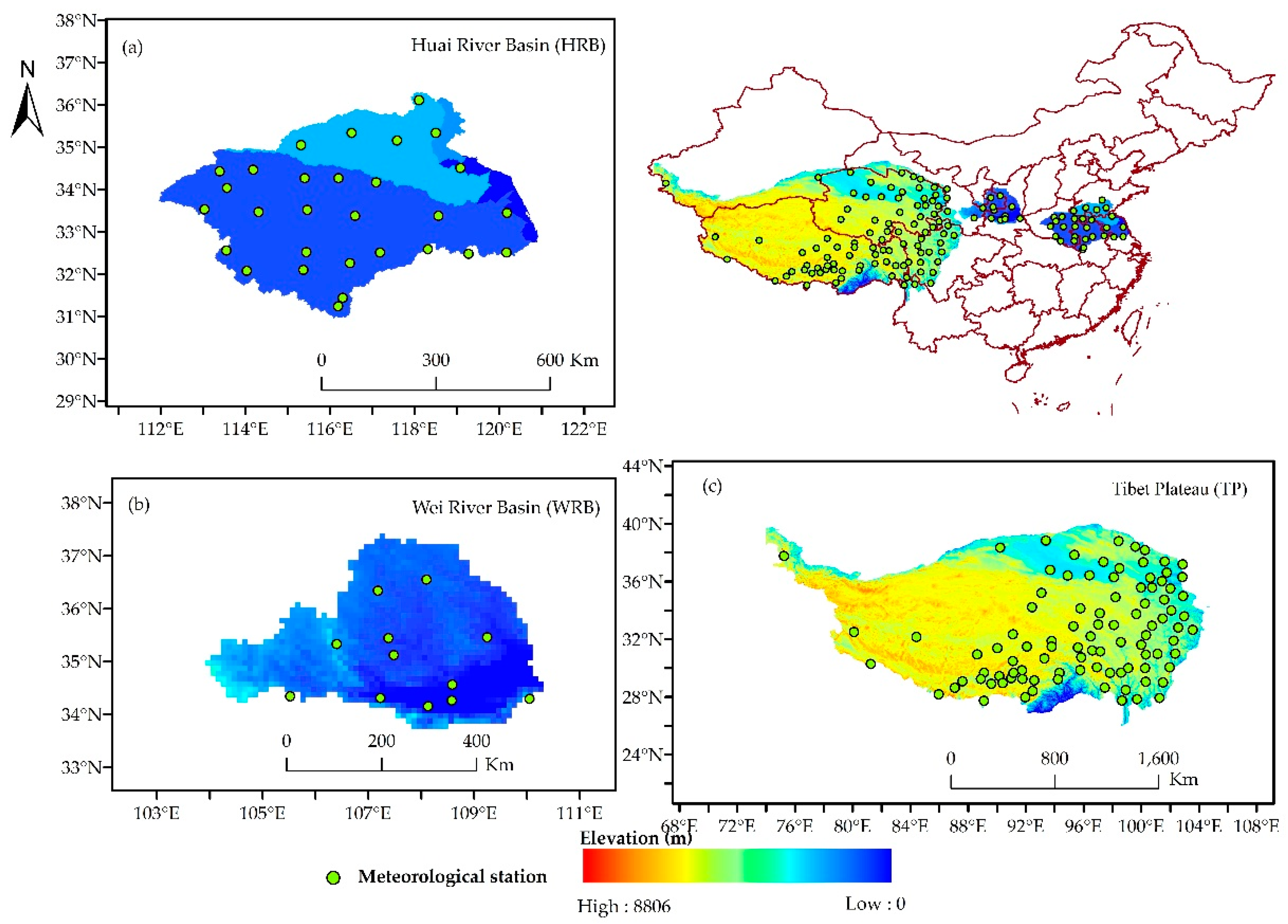
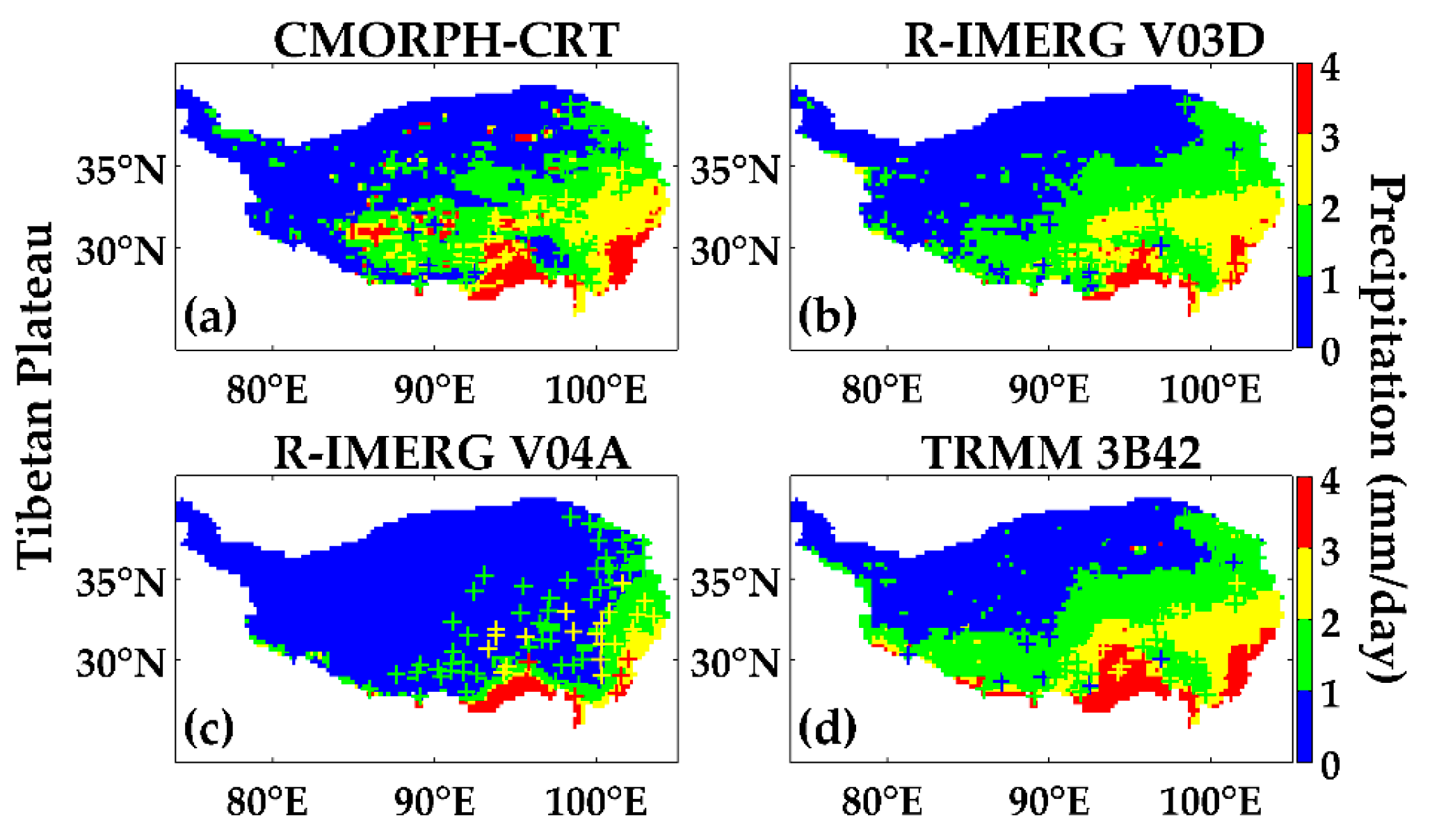
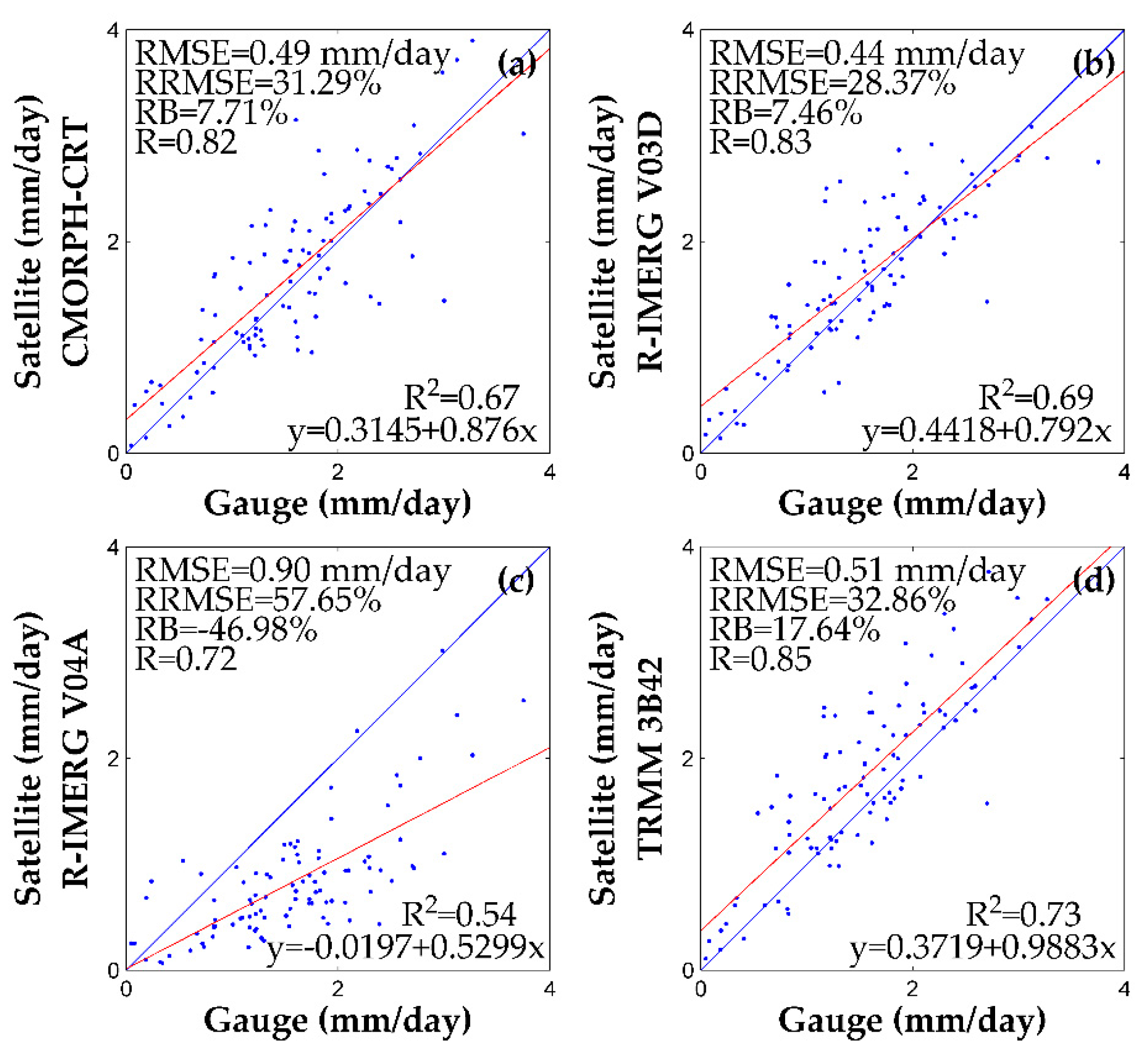
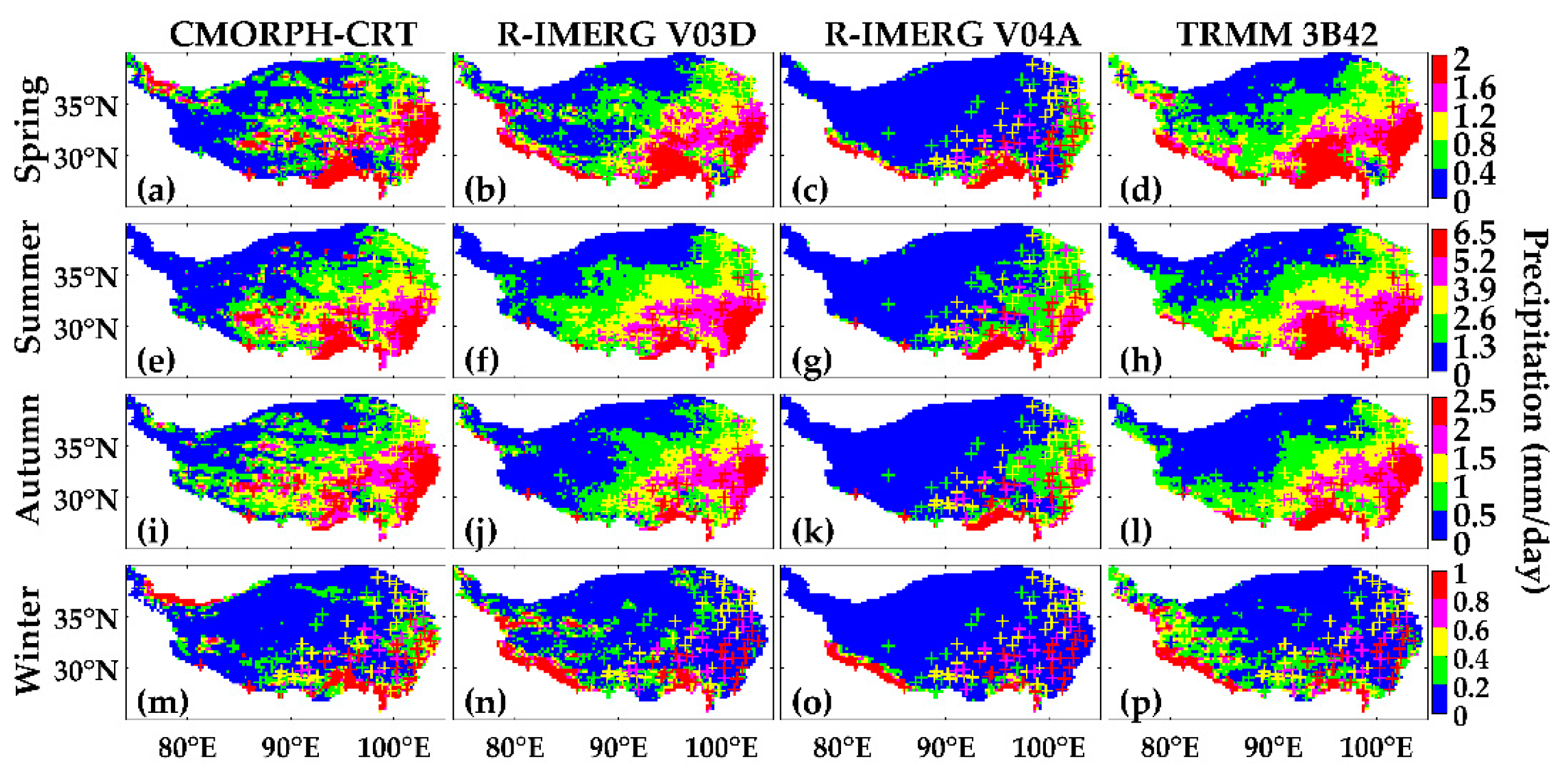
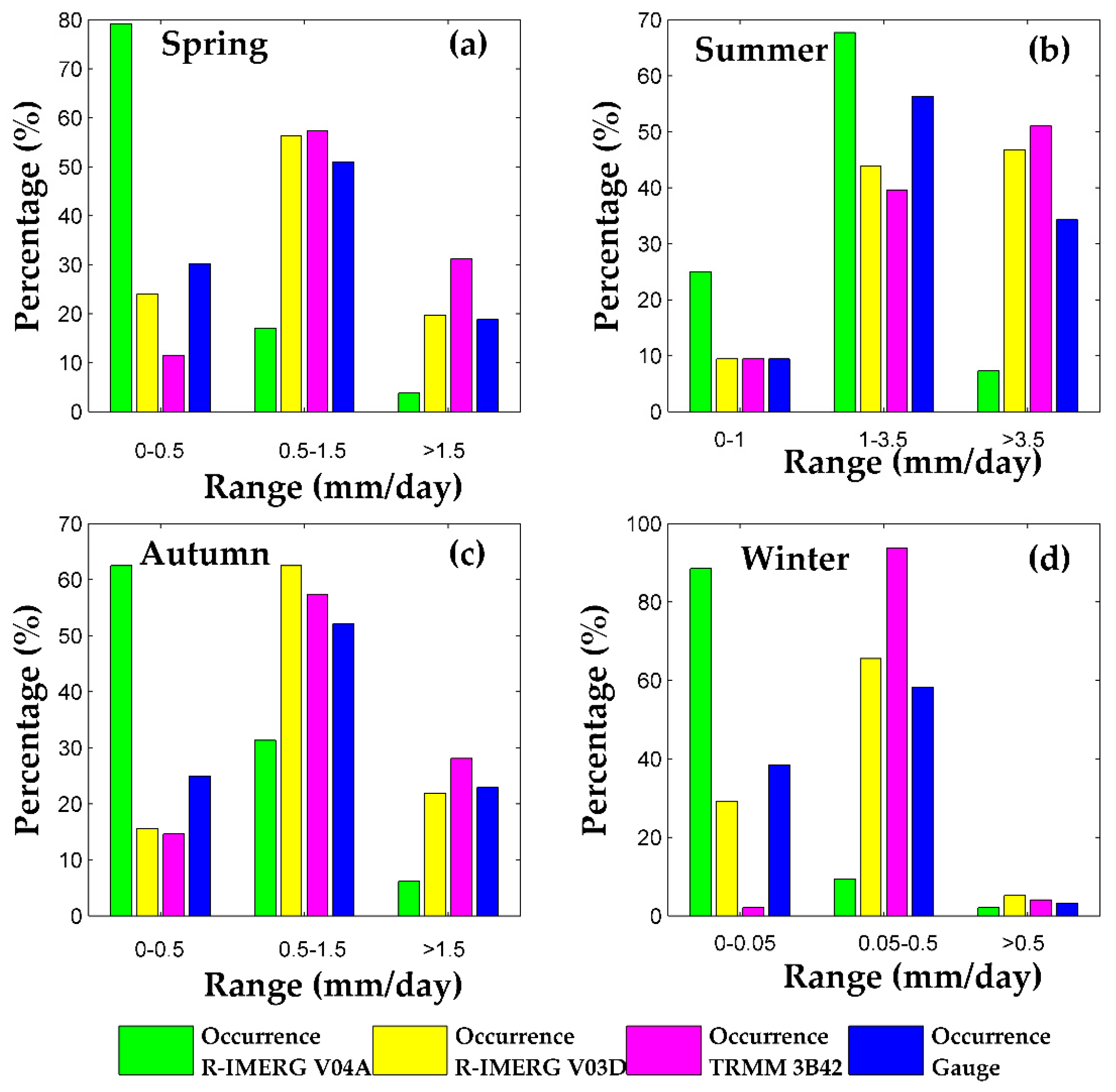
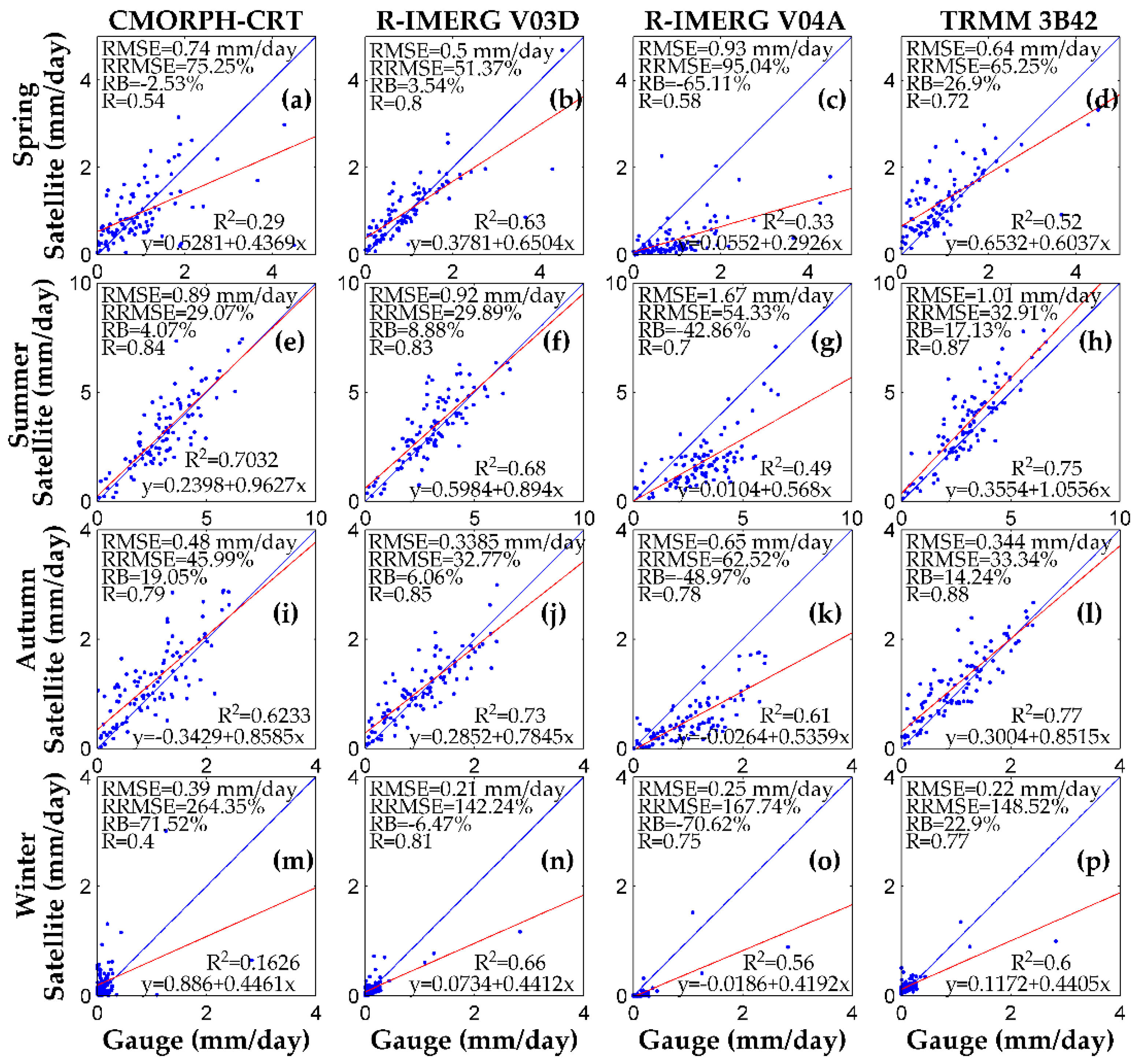
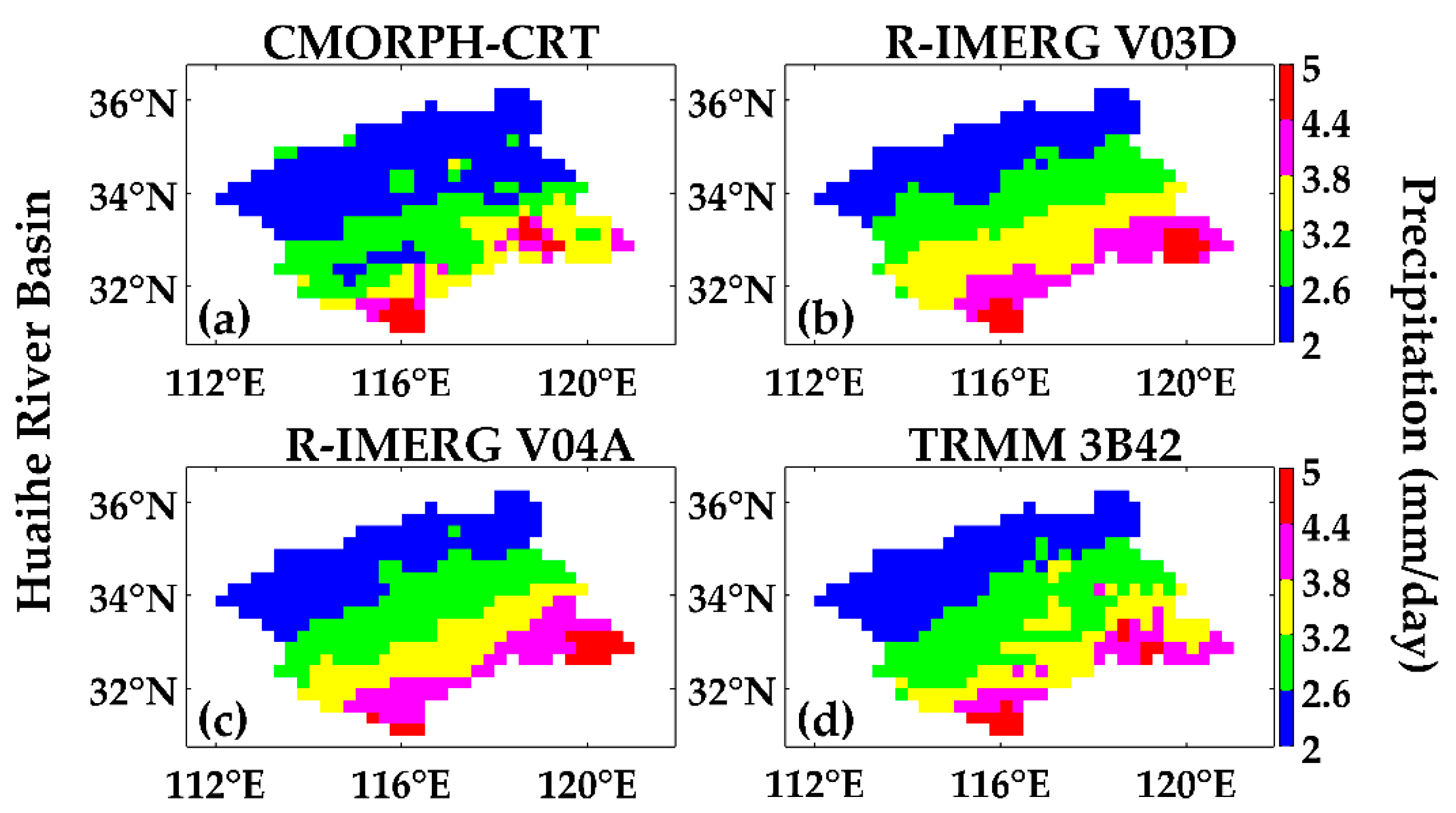

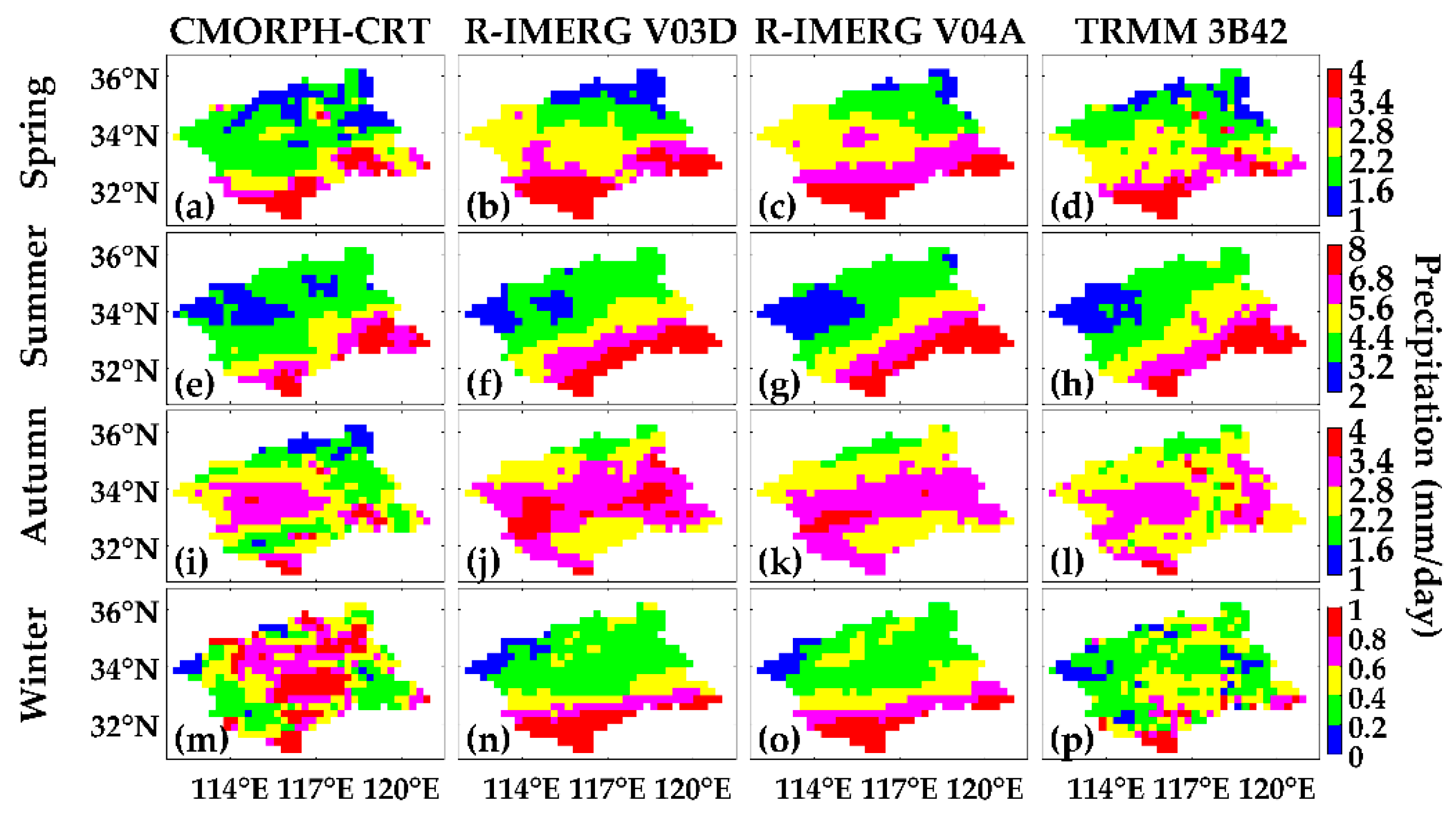

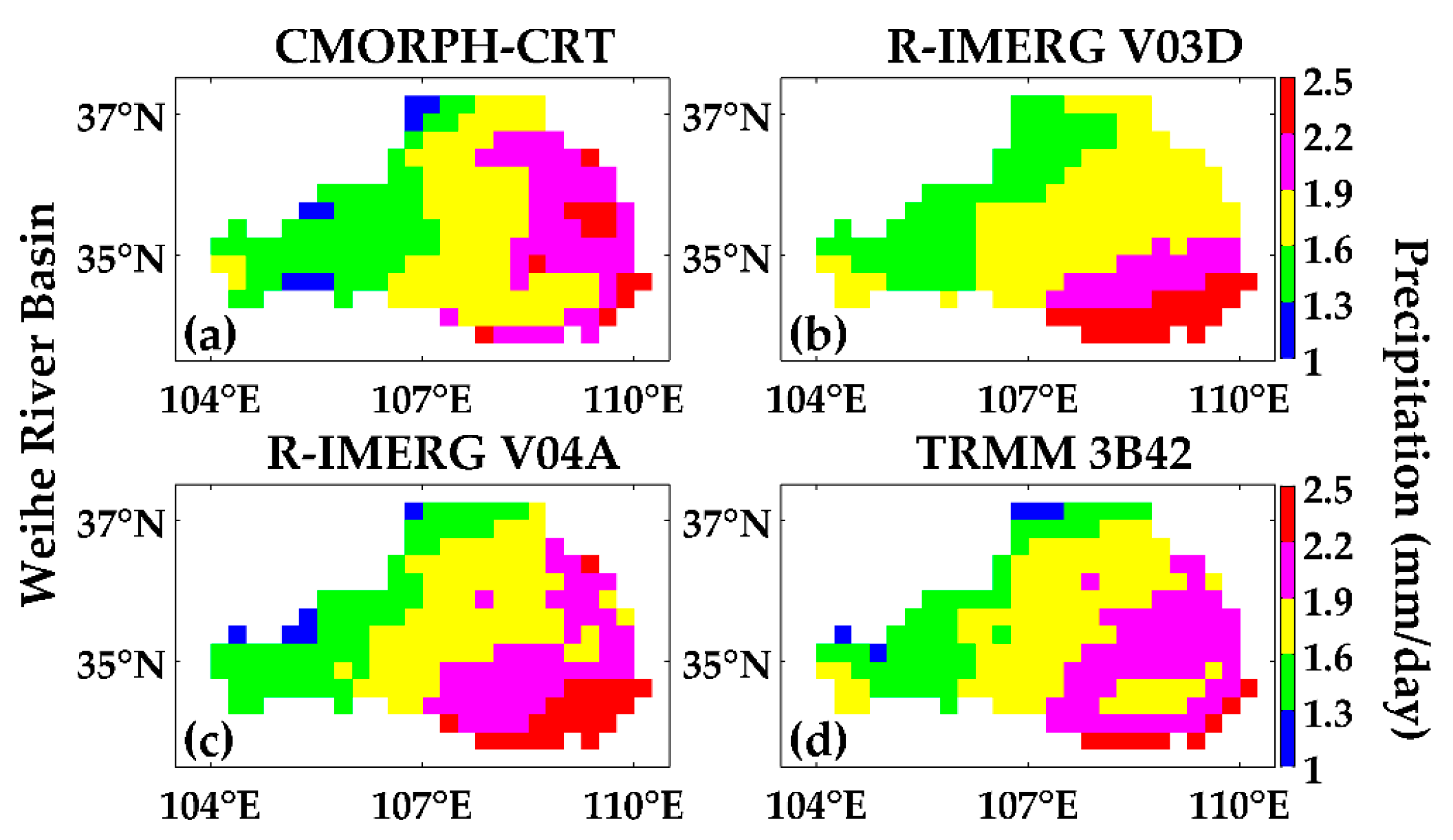
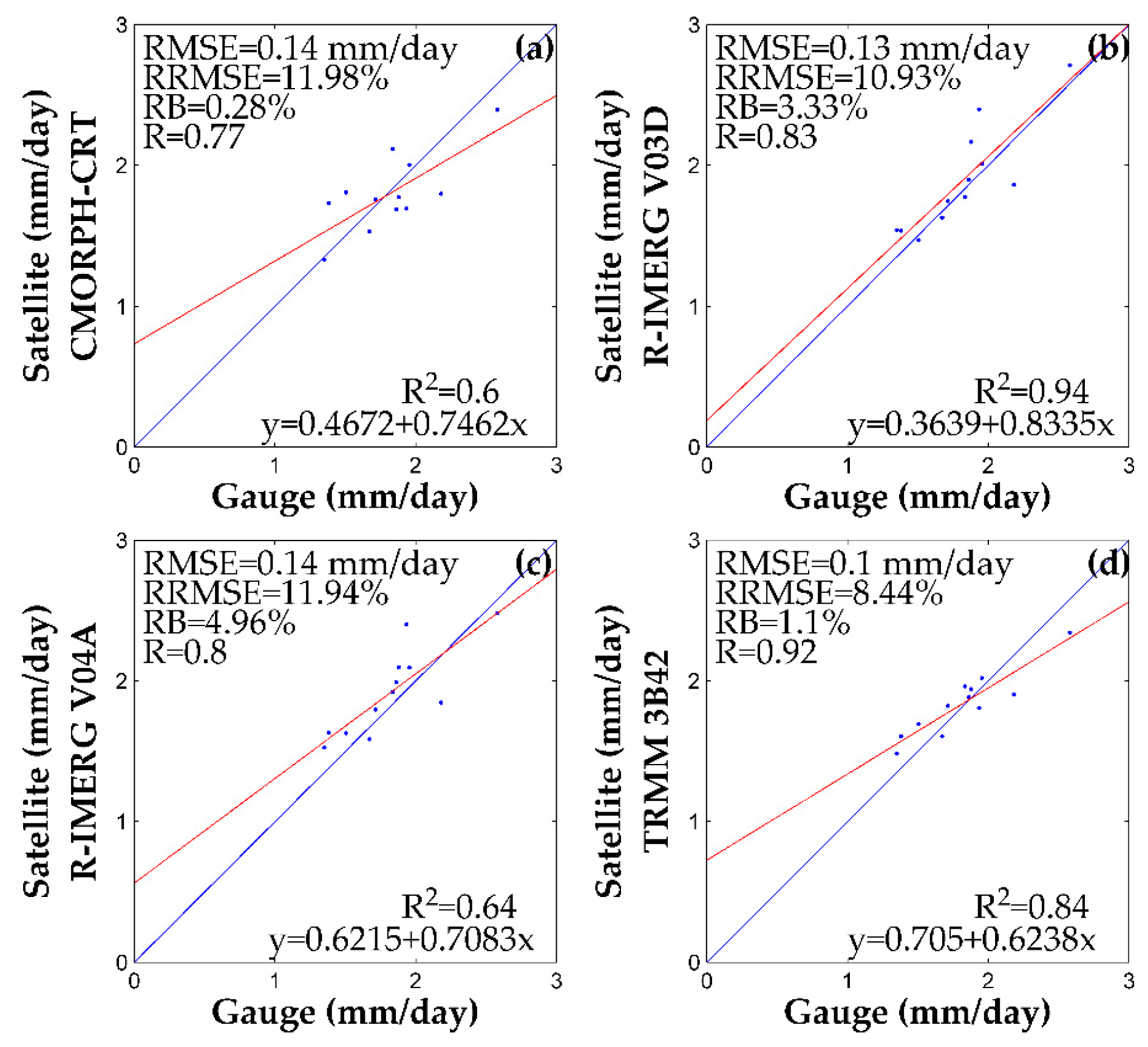
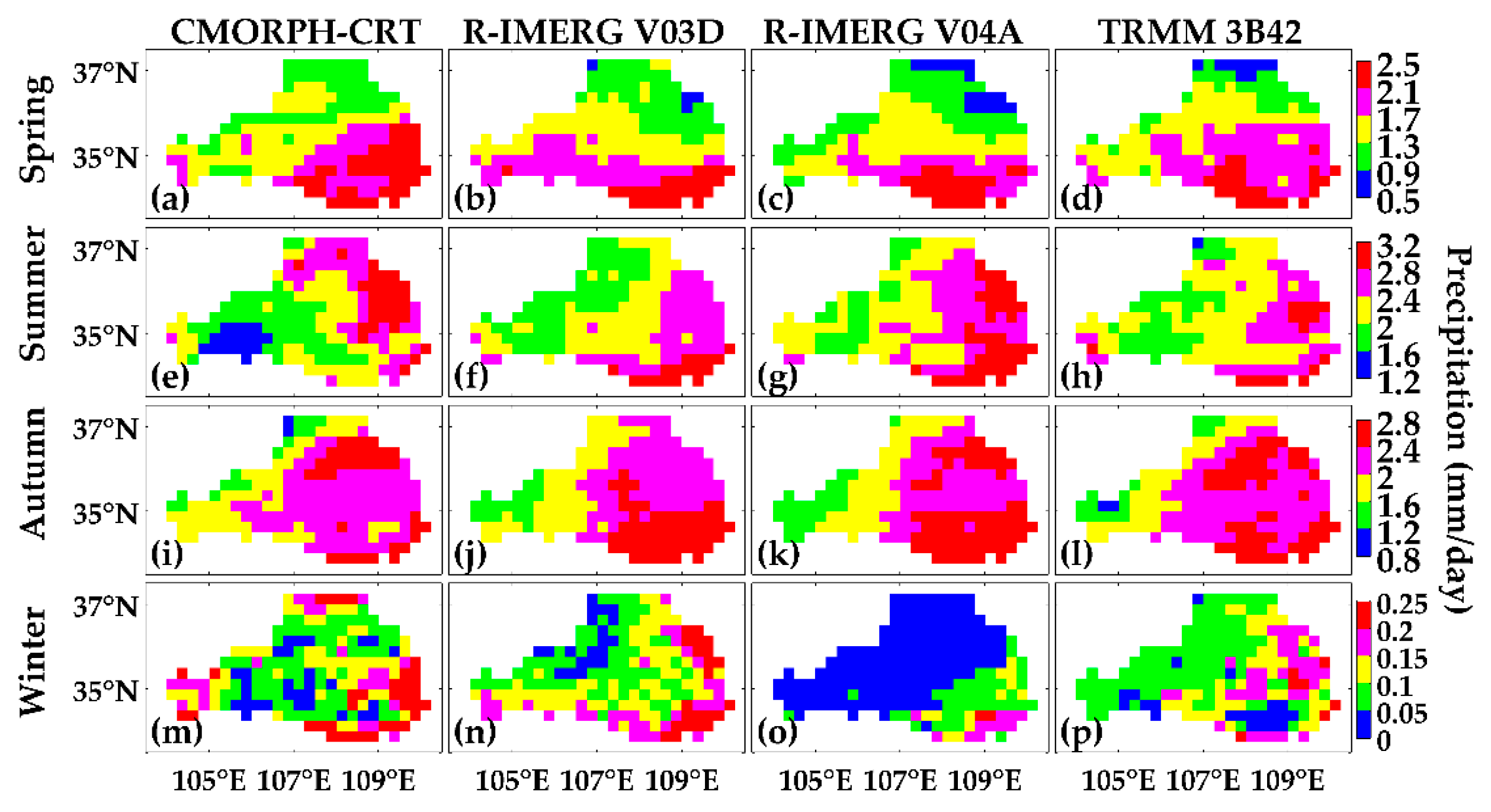
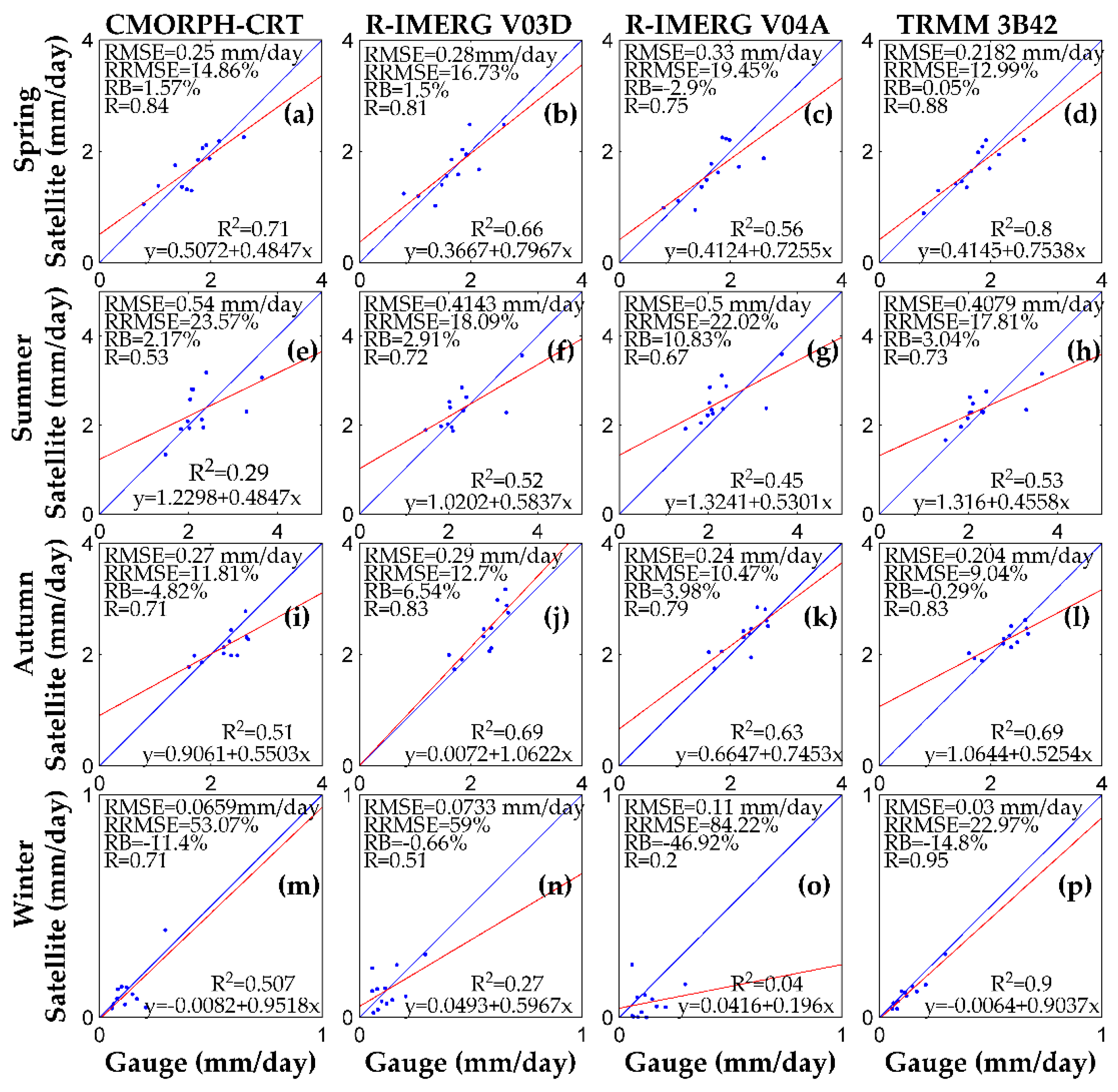
| Watersheds | Tibetan Plateau | Huaihe River Basin | Weihe River Basin |
|---|---|---|---|
| Average elevation | 4292 m | 84 m | 2173 m |
| Annual average temperature | 2–5 °C | 11–16 °C | 10–13 °C |
| Annual average rainfall | 482.8 m | 1100 m | 559 m |
| Glaciers and permafrost | Yes | No | No |
| Climate | Cold region | Semi-humid | Arid/semi-arid |
| Number of stations | 96 | 29 | 12 |
© 2017 by the authors. Licensee MDPI, Basel, Switzerland. This article is an open access article distributed under the terms and conditions of the Creative Commons Attribution (CC BY) license (http://creativecommons.org/licenses/by/4.0/).
Share and Cite
Wei, G.; Lü, H.; T. Crow, W.; Zhu, Y.; Wang, J.; Su, J. Evaluation of Satellite-Based Precipitation Products from IMERG V04A and V03D, CMORPH and TMPA with Gauged Rainfall in Three Climatologic Zones in China. Remote Sens. 2018, 10, 30. https://doi.org/10.3390/rs10010030
Wei G, Lü H, T. Crow W, Zhu Y, Wang J, Su J. Evaluation of Satellite-Based Precipitation Products from IMERG V04A and V03D, CMORPH and TMPA with Gauged Rainfall in Three Climatologic Zones in China. Remote Sensing. 2018; 10(1):30. https://doi.org/10.3390/rs10010030
Chicago/Turabian StyleWei, Guanghua, Haishen Lü, Wade T. Crow, Yonghua Zhu, Jianqun Wang, and Jianbin Su. 2018. "Evaluation of Satellite-Based Precipitation Products from IMERG V04A and V03D, CMORPH and TMPA with Gauged Rainfall in Three Climatologic Zones in China" Remote Sensing 10, no. 1: 30. https://doi.org/10.3390/rs10010030
APA StyleWei, G., Lü, H., T. Crow, W., Zhu, Y., Wang, J., & Su, J. (2018). Evaluation of Satellite-Based Precipitation Products from IMERG V04A and V03D, CMORPH and TMPA with Gauged Rainfall in Three Climatologic Zones in China. Remote Sensing, 10(1), 30. https://doi.org/10.3390/rs10010030





